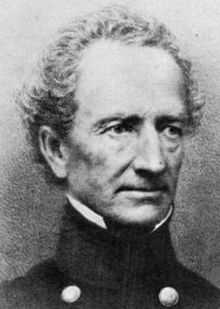James Wolfe Ripley
| James Wolfe Ripley | |
|---|---|
 | |
| Born |
December 10, 1794 Windham County, Connecticut |
| Died |
March 16, 1870 (aged 75) Hartford, Connecticut |
| Place of burial | Hartford, Connecticut |
| Allegiance |
United States of America Union |
| Service/branch |
United States Army Union Army |
| Years of service | 1814 - 1863 |
| Rank |
Brigadier General Brevet Major General |
| Battles/wars | American Civil War |
James Wolfe Ripley (December 10, 1794 – March 16, 1870) was an American soldier, serving as a brigadier general in the Union Army during the Civil War. He was instrumental in the early days of the war in modernizing the artillery's ordnance. However, Ripley also delayed the introduction of repeating rifles into U.S. arsenals, an act that has been widely criticized by later historians.
Biography
Ripley was born in Windham County, Connecticut. He graduated at West Point in 1814, was commissioned second lieutenant of artillery, and took part in the defense of Sacketts Harbor. In 1817–18 he served under Jackson during the Seminole War and the invasion of Florida as a first lieutenant. He was promoted to captain in 1825.
In 1832-33, Ripley commanded the Federal forces in Charleston harbor at the time of the nullification movement in South Carolina. He was promoted to major of ordnance in 1838. He commanded the Kennebec arsenal between 1833 and 1842.[1] Between 1842 and 1854, Ripley was superintendent of the Springfield Armory in Massachusetts.[1] In 1854 he was transferred to the Watertown Arsenal as commandant of the facility, with the rank of lieutenant colonel. Then he was chief of ordnance of the Pacific Coast Department and inspector of arsenals.[1]
With the outbreak of the Civil War in early 1861, Ripley was promoted to colonel (April) and brigadier general (August) and appointed chief of ordnance of the army. As the Federal forces then had no heavy rifled cannon, he immediately ordered the conversion of old smoothbores and the manufacture of Parrott guns.
At the same time, Ripley refused to authorize the purchase of additional stocks of rifle-muskets for infantry use. The decision was based on the large existing stocks of smoothbore muskets in U.S. arsenals, which he argued could be re-rifled in the same manner as the Parrott guns (an assertion which proved incorrect). He also adamantly opposed the introduction of breech-loading repeating rifles, on the basis that they would encourage poor fire discipline and waste ammunition.
Many historians have since decried this decision, arguing the lack of modern arms on the Union side, at a time when the Confederates were buying them in large numbers from France and the United Kingdom, lengthened the conflict by as much as two years. Others, however, counter that given the poor logistics of the Union armies at the outbreak of the war, the increased supply train needed to maintain the improved rates of fire would have bogged down the armies and made maneuver impossible (a situation which did indeed later contribute to the development of trench warfare in World War I). It is also argued that fouling due to black powder residue would have made it impossible to maintain such high rates of fire under field conditions with the rifles of the time. Individual units would later purchase such weapons privately, and they were used to considerable effect, but did indeed present problems in extended firefights; these units are not known to have had any trouble maintaining their ammunition supplies. Ripley was replaced as head of the Ordnance Department on September 15, 1863 principally because of his continuing opposition to the introduction of breech loading rifles.[1][2]
From September 15, 1863 to the year of his death, he was inspector of fortifications on the New England coast, having retired from active service.[1][2] On March 8, 1866, President Andrew Johnson nominated Ripley to the grade of brevet major general in the regular army, to rank from March 13, 1865, and the U.S. Senate confirmed the appointment on July 14, 1866.[3] James Wolfe Ripley died on March 16, 1870 in Hartford, Connecticut. He is buried in Springfield, Massachusetts.[1][2]
His nephew, Roswell S. Ripley, was a Confederate brigadier general during the Civil War.
See also
Notes
- ↑ 1.0 1.1 1.2 1.3 1.4 1.5 Warner, Ezra J. Generals in Blue: Lives of the Union Commanders. Baton Rouge: Louisiana State University Press, 1964. ISBN 0-8071-0822-7. pp. 404–405
- ↑ 2.0 2.1 2.2 Eicher, John H., and David J. Eicher, Civil War High Commands. Stanford: Stanford University Press, 2001. ISBN 0-8047-3641-3. p. 454
- ↑ Eicher, 2001, p. 708
References
- Eicher, John H., and David J. Eicher, Civil War High Commands. Stanford: Stanford University Press, 2001. ISBN 0-8047-3641-3.
- Warner, Ezra J. Generals in Blue: Lives of the Union Commanders. Baton Rouge: Louisiana State University Press, 1964. ISBN 0-8071-0822-7.
 This article incorporates text from a publication now in the public domain: Gilman, D. C.; Thurston, H. T.; Moore, F., eds. (1905). "article name needed". New International Encyclopedia (1st ed.). New York: Dodd, Mead.
This article incorporates text from a publication now in the public domain: Gilman, D. C.; Thurston, H. T.; Moore, F., eds. (1905). "article name needed". New International Encyclopedia (1st ed.). New York: Dodd, Mead. This article incorporates text from a publication now in the public domain: Wilson, James Grant; Fiske, John, eds. (1891). "article name needed". Appletons' Cyclopædia of American Biography. New York: D. Appleton.
This article incorporates text from a publication now in the public domain: Wilson, James Grant; Fiske, John, eds. (1891). "article name needed". Appletons' Cyclopædia of American Biography. New York: D. Appleton.
|